- Home
- David R. George III
The Fire and the Rose
The Fire and the Rose Read online
Crucible
The Fire and the Rose
David R. George III
POCKET eBOOKS
New York London Toronto Sydney Singapore
An Original Publication of POCKET eBOOKS
This eBook is a work of fiction. Names, characters, places and incidents are products of the author's imagination or are used fictitiously. Any resemblance to actual events or locales or persons living or dead is entirely coincidental.
POCKET eBOOKS, a division of Trevor & Simon, Inc.
Copyright © xxxx by Paramount Pictures. All Rights Reserved.
STAR TREK is a Registered Trademark of Paramount Pictures.
This book is published by Pocket eBooks, a division of Trevor & Simon, Inc., under exclusive license from Paramount Pictures.
All rights reserved, including the right to reproduce this book or portions thereof in any form whatsoever.
ISBN: xxx-xxx-xxx-x
Pocket eBook first published February 2007
Foreword
The Fire and the... Well, Not So Much Fire
So I’ve got my approach for this Star Trek trilogy that is intended to help celebrate the fortieth anniversary of the show. First, I will base it solely on the original episodes and the films (and maybe a little of the animated series, just for good measure). Check. Second, though the novels will include all of the familiar faces—Scotty, Sulu, Uhura, Chekov, and others—I will focus each book on one of the three main characters of McCoy, Spock, and Kirk. Check. Third, I will tie the stories together through this one event, this crucible, that I have posited had a significant and abiding impact on the lives of those three. Check.
I finish the outline for the McCoy tale and move on to that for the Spock story. And as I did with McCoy, I ask myself what we don’t already know about Spock. Amazingly, I quickly devise an answer. The last time, chronologically, that the character appeared in the Star Trek universe, he dwelled secretly on Romulus, working toward reunification of the ancestrally related Vulcans and Romulans. But how did he get there, and after being seen in The Next Generation’s two-part episode “Unification,” what happened to him? Moreover, was there some way I could tie this into my notion of the crucible? As it turned out, yeah, there was.
So I wrote a long and detailed outline. It contained complex politics, roaring action, and more than a little character exploration. In the end, I thought that I had constructed a pretty good story.
I then scrapped it.
After thinking about it for a while, and after mentioning some of my ideas to my valiant editor, Marco Palmieri—who had yet to receive the outline—I decided that my tale did not really fit in with celebrating the Original Series. Spock would be the main character, yes, and there would be a series of flashback scenes that took us back to Kirk and McCoy and the rest of the Enterprise crew, but still, it seemed wrong to set a Star Trek anniversary novel fundamentally in the Next Generation era.
So now what? Well, again I asked myself what I didn’t know about Spock—and in particular, what did I not know about him from the series and films? I pondered the question for a while, mulled it over, cogitated about it, and then, as had happened with my exploration of McCoy, I saw something hiding in plain sight. Spock had done something in his life—something big—that remained completely unexplained. I wanted to explain it, but I didn’t necessarily want to do so by looking at that precise event. Maybe, I thought, Spock could decide to do something big again, and I could then explore that, while at the same time harking back to the first big event, finding parallels between the two.
Okay, not bad. But would the notion of the crucible tie in? It did, and in a way I especially liked, one that would provide some significant overlap with the McCoy novel. Things really seemed to be falling into place.
Once more, I was off and running.
We shall not cease from exploration
And the end of all our exploring
Will be to arrive where we started
And know the place for the first time.
Through the unknown, unremembered gate
When the last of earth left to discover
Is that which was the beginning;
At the source of the longest river
The voice of the hidden waterfall
And the children in the apple-tree
Not known, because not looked for
But heard, half-heard, in the stillness
Between two waves of the sea.
Quick now, here, now, always—
A condition of complete simplicity
(Costing not less than everything)
And all shall be well and
All manner of thing shall be well
When the tongues of flame are in-folded
Into the crowned knot of fire
And the fire and the rose are one.
—T. S. Eliot, Little Gidding, V
Leila: We’re happy here…. I can’t lose you now, Mister Spock.
Spock: I have a responsibility…. To this ship… to that man on the bridge. I am what I am, Leila, and if there are self-made purgatories, then we all have to live in them.
—“This Side of Paradise”
Overture
Left of the Pointed Peaks
As he regained consciousness, his head pounded and he felt—
Nothing, Spock told himself, the thought by now reflexive. I feel nothing. Not emotionally, at least, though pain suffused his physique and fatigue clouded his intellect. The energy bolt that had slammed into him, that had evidently sent him sprawling unconscious to the floor, had left a residue of deep aches buried in his muscles and joints, and a fog of exhaustion blurring his thoughts. But he had no time even to will away his discomfort. Recalling the urgency of the situation, he would simply have to ignore the throes of soreness throughout his body, the mists of weariness throughout his mind.
Keeping his eyes closed for the moment, Spock sought to focus. When he’d done so sufficiently, he listened closely to the sounds of his surroundings. The low hum of the force field had gone, he noted. He heard no voices, no footsteps, no movement of any kind, except… there, near the limits of his perception… not here in the corridor, but somewhere nearby, the quiet rhythms of somebody breathing.
But not Mitchell, he thought. Spock recognized the pattern of slightly labored respiration and knew that it belonged not to the Enterprise’s mutated helmsman, but to the ship’s elderly chief medical officer. He heard no one else.
Spock opened his eyes and saw the glow of the lighting panels in the ceiling above him. He pushed himself up from his supine position, his arms throbbing, his equilibrium slipping. He paused, clearing his mind by concentrating on a single set of sensations, that of the concrete—solid, porous, and cool—beneath his hands.
Ahead of him, what he could see of Mitchell’s cell stood empty, the frame that edged the entryway and generated the confinement field now dark. Rising to his feet, Spock peered about the area, then moved into the makeshift brig that the Enterprise’s security staff had improvised here on Delta Vega. The small, rectangular room contained only a bed, a basin and mirror, and a lavatory. He saw no sign of Gary Mitchell—or of whatever the lieutenant commander had become—nor did he see Captain Kirk or Dr. Dehner, both of whom had been present when Mitchell had struck. Despite being imprisoned behind a force field, the increasingly powerful officer had attacked his jailors, creating and controlling a jagged web of energy, toppling first the captain and then Spock.
Now, as familiar footfalls approached, Spock walked back out into the corridor. There, he noticed also missing the phaser rifle he’d ordered sent down from the ship. He’d wanted to keep it on hand for defensive purposes in the event that Mitchell managed t
o escape his captivity. Unfortunately, though Spock had brought the weapon to bear, he’d been unable to fire before being knocked out.
Dr. Piper emerged into the corridor from around a corner. The grizzled, craggy-faced human carried his black medical bag on a strap across his shoulder. “Spock,” he said, “when did you come to?” He swung his bag around in front of him and began looking through it.
“Just now,” Spock said. “Have you seen the other members of the landing party? Or Mitchell?”
Piper peered up at Spock with a grave expression on his face. “Kelso’s dead,” he said, referring to the Enterprise’s first-shift navigator. “I found him in the control room, strangled with a length of cable.”
A twinge of sadness rose within Spock, a reaction to the loss of life—particularly to the unnecessary loss of life—and he tamped it back down. Kelso had just finished leading an effort here at the automated lithium-cracking station to scavenge the equipment needed to patch and reenergize the Enterprise’s main drive enough to allow it to reach the nearest repair base. Along with the captain, Dr. Piper, Dr. Dehner, and Spock, the lieutenant composed the last of the landing parties still on the planet. The five officers had been on the verge of transporting back to the ship, stranding their prisoner here, when Mitchell had staged his assault.
“What about Captain Kirk and Doctor Dehner?” Spock asked.
Piper looked back down at his medical bag and extracted a small pouch from it. “When I came through the control room and saw Kelso, I spotted Gary and Doctor Dehner walking out across the valley, toward the left of the pointed peaks,” he said. “After that, I found you and the captain here.” He gestured down at the floor, then took a white pill from the pouch. Holding the medication out to Spock, he said, “I revived Captain Kirk and gave him one of these. You should take one too.”
Spock accepted the pill, but did not at once ingest it. “Where is the captain now?” he asked.
“He took the phaser rifle and went after Gary,” Piper said, and Spock noted that Mitchell must have become so powerful that he hadn’t felt the need to commandeer the weapon, either to defend himself or to keep it from his pursuers. “The captain wanted me to wait until he’d gone before bringing you around. He left orders for us to go back to the Enterprise immediately. If you haven’t heard from him in twelve hours, he wants you to take the ship to the nearest starbase and deliver his recommendation that this planet be blanketed with lethal doses of neutron radiation.”
“Yes,” Spock said, understanding Captain Kirk’s rationale. Given Mitchell’s growing strength and abilities, as well as his commensurate and amoral ambitions, he had to be stopped here, at the outskirts of the galaxy, far from any population centers. As Spock considered the situation, pain and weariness overtook his thoughts. The doctor must have noticed his momentary distraction, because he pointed at the pill he’d handed to the Vulcan.
“You really should take that,” Piper said. “I know what you’re experiencing. Whatever Gary hit you and the captain with, he hit me with it too.”
“What is this?” Spock asked, holding up the pill.
“An analgesic combined with a mild stimulant,” the doctor said. “It’ll help you concentrate.”
Spock placed the pill in his mouth and swallowed it. “How long has it been since Mitchell attacked us?” he asked.
“Ninety minutes,” Piper said. “And it’s been half that long since the captain came to and went after Gary and Doctor Dehner.”
“Could you ascertain whether Mitchell took the doctor with him as a hostage?” Spock asked. It made sense that Dehner had been taken against her will, but because of her obvious interest in Mitchell—both in his transformation and on a personal level—Spock allowed that she might have gone along willingly.
“No, I couldn’t tell,” Piper said. “She was walking alongside him, but that doesn’t mean that he wasn’t forcing her to go with him.”
Spock nodded, then pulled his communicator from where it hung at the back of his waist. When he unfolded the gold grille that functioned as antenna and activation control, the device chirped, indicating its functional status. “Spock to Enterprise,” he said.
“I’ve been trying,” Piper told him. “I can’t get through.” As though in confirmation of the doctor’s assertion, the communicator emitted a burst of static. Spock closed the device and placed it back on his belt.
“In that case,” he said, “since we are unable to follow the captain’s orders and return to the ship—” Unexpectedly, his communicator beeped twice, signaling an incoming transmission. Retrieving it once more, he again opened the grille.
“Enterprise to landing party,” came the voice of the ship’s chief engineer. Fourth in the crew hierarchy, Lieutenant Commander Scott had been left in command with Kirk and Spock away from the ship and Mitchell relieved of duty. He sounded insistent and concerned.
“Spock here.”
“Mister Spock,” Scott said, a note of surprise in his tone. “We’ve been trying to reach the landing party for more than an hour. Is everything all right?”
“Negative,” Spock replied. “Lieutenant Kelso has been killed. Mitchell has escaped and fled the lithium plant, taking Doctor Dehner with him, and Captain Kirk has gone in pursuit.” Scott uttered a Gaelic oath. “Doctor Piper is here with me. Transport the two of us back to the ship at once.”
“Aye, sir,” Scott said. “Right away.”
“Spock out.” He replaced the communicator on his belt, his mind already turning to the task of utilizing the ship’s sensors to search for both the captain and Mitchell. As he thought about what other actions he could take, the whine of the transporter grew in the corridor.
The sky burned.
Spock bent over the hooded sensor monitor at his sciences station and studied the dramatic atmospheric effects. A cavity cleft the ozone layer, he saw, allowing the ultraviolet rays of the Delta Vega sun to penetrate through to the troposphere and the planet’s surface. But the perforation of the jacket of trivalent oxygen ensphering the world did not adequately explain the stratum of fiery matter hovering above the cloud cover.
Below it, he knew, Captain Kirk might already be dead.
Standing up straight, Spock looked toward the front of the Enterprise bridge at the main viewscreen. On it rotated the reddish brown planet about which the ship still orbited, the remote site of the uncrewed lithium facility, where years passed between visits by ore freighters. Bands of gray white clouds swept across the globe, and in one location, Spock could see the brilliant orange patch of plasma that floated in space above the valley containing the mining and processing plant.
Until four hours ago, the swath of superheated, ionized gas hadn’t existed. According to Chief Engineer Scott, he’d been on the bridge, speaking via communicator with Lieutenant Kelso, when the phenomenon had spontaneously manifested. Scott had lost contact with Kelso, and his subsequent efforts to reach the other members of the landing party had also failed, blocked by the sheet of plasma, until finally he’d gotten through to Spock. At that time, the blaze of ions, free electrons, and neutral atoms had receded just enough to allow communications and transporter operation between the Enterprise and the ore station. As soon as Spock and Piper had beamed aboard, though, the mass of plasma had expanded back into place, shrouding the entire valley.
In light of those events, Spock concluded that Mitchell’s abilities had developed to include the creation and manipulation of the obstructive matter in the atmosphere. If so, then the erstwhile helmsman likely had for some reason allowed Spock and Piper to transport up to the ship, though it appeared that he would not permit any of the crew to beam back down. In addition, the interference produced by the plasma prevented them from employing sensors to locate Mitchell, then transporting him from the surface of the planet and into whatever new prison they could construct for him—or into the lethal environment of space. Neither could they track the captain and Dr. Dehner in order to initiate their rescue.
&n
bsp; Spock sat down at his sciences station and turned toward the communications console. “Mister Alden,” he said, “has there been any change in the intensity of the interference?”
“There’s been some fluctuation, sir,” Alden said, his hand going to the silver receiver protruding from his left ear. “But not enough to allow our instruments to break through.”
Spock considered this, wondering whether Mitchell needed a constant effort to preserve the plasma field, or if once established, it sustained itself. “Continue attempting to reach the captain,” he told Alden. Spock looked back toward the main viewer, deciding what preparations to make. Captain Kirk’s last orders, delivered through Dr. Piper, had been clear, but with the captain having been gone for hours, Spock needed to ready the crew for various contingencies.
This entire situation had begun when the ship had essentially followed in the path of the S.S. Valiant, an Earth vessel lost two centuries earlier, its commanding officer apparently ordering its destruction after it had encountered an unpredicted energy barrier at the edge of the galaxy. The Enterprise’s own trip through the unexplained field had left the main engines down, nine of the crew dead, and two others—Mitchell and Dr. Elizabeth Dehner—struck by some sort of charge. When Dehner, a psychiatrist assigned to the ship to study crew reactions in emergency conditions, had recovered, she’d seemed unaffected. Mitchell, on the other hand, had acquired a strange, silvery glow in his eyes, a radically amplified mental capacity, the facilities of telepathy and telekinesis, and the ability to generate bolts of electrical energy that he could wield as weapons. Perhaps more significantly, as his powers had continued to increase at an exponential pace, his personality had shifted from that of a fun-loving but capable Starfleet officer to that of a megalomaniac. He’d spoken of using worlds and of squashing his crewmates as he could insects. Spock had quickly determined that he would have to be stopped. Since then, Mitchell’s words and actions had served only to buttress that judgment.

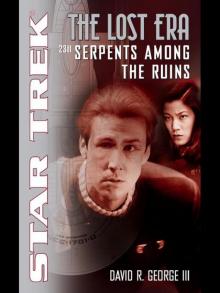 Serpents Among the Ruins
Serpents Among the Ruins The Fire and the Rose
The Fire and the Rose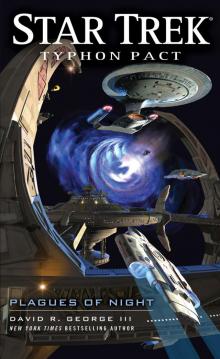 Star Trek: Typhon Pact 06: Plagues of Night
Star Trek: Typhon Pact 06: Plagues of Night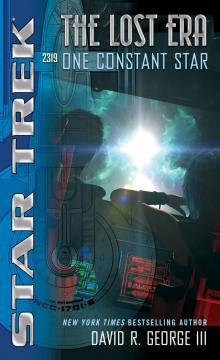 Star Trek: The Lost Era - 08 - 2319 - One Constant Star
Star Trek: The Lost Era - 08 - 2319 - One Constant Star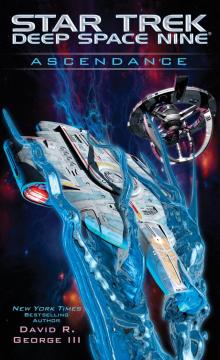 Star Trek: Deep Space Nine: Ascendance
Star Trek: Deep Space Nine: Ascendance Star Trek: TOS: Allegiance in Exile
Star Trek: TOS: Allegiance in Exile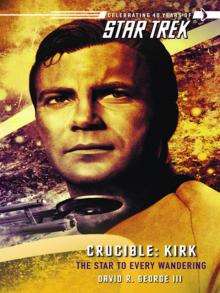 Crucible: Kirk
Crucible: Kirk Crucible: McCoy
Crucible: McCoy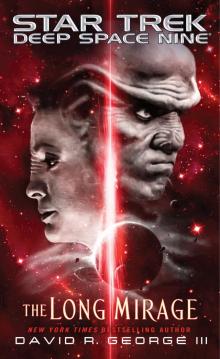 The Long Mirage
The Long Mirage Original Sin
Original Sin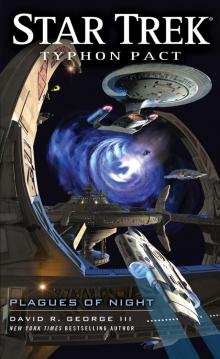 Star Trek: Typhon Pact: Plagues of Night
Star Trek: Typhon Pact: Plagues of Night Allegiance in Exile
Allegiance in Exile Sacraments of Fire
Sacraments of Fire Star Trek: Typhon Pact: Rough Beasts of Empire
Star Trek: Typhon Pact: Rough Beasts of Empire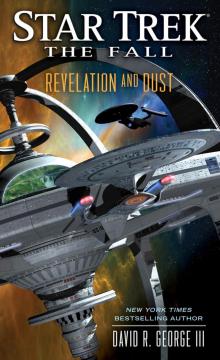 Star Trek: The Fall: Revelation and Dust
Star Trek: The Fall: Revelation and Dust